Hippocampus
links: Neuroanatomy reference: 10-4-2021
Hippocampus #
- Required for the reactivation of recent memories of 15 seconds to 2 years (bit of a broad definition of “recent”), but not remote memories of >2 years, or immediate (0-15s).
Circuits #
- Trisynaptic circuit (literally consisting of 3 synapses) = DG (mossy fibers)→CA3 (Schaffer collaterals)→CA1. Pattern separation, pattern completion, and then an integration.
- But I don’t get it, exactly. It’s not a linear change of events like one may assume. It integrates CA3 and EC information, for one.
-
Function of local circuits in the hippocampal dentate gyrus-CA3 system
- Mostly excitatory stellate cells?
- Is GABA Co-Released with Glutamate from Hippocampal Mossy Fiber Terminals interesting subject. I think I’ve read this or something like it before wrt. development. GABAergic and glutamatergic co-localization in mossy fiber boutons has been observed primarily in the developing hippocampus, but in adulthood, evidence suggests that mossy fiber synapses may alternate which neurotransmitter is released through activity-dependent regulation
-
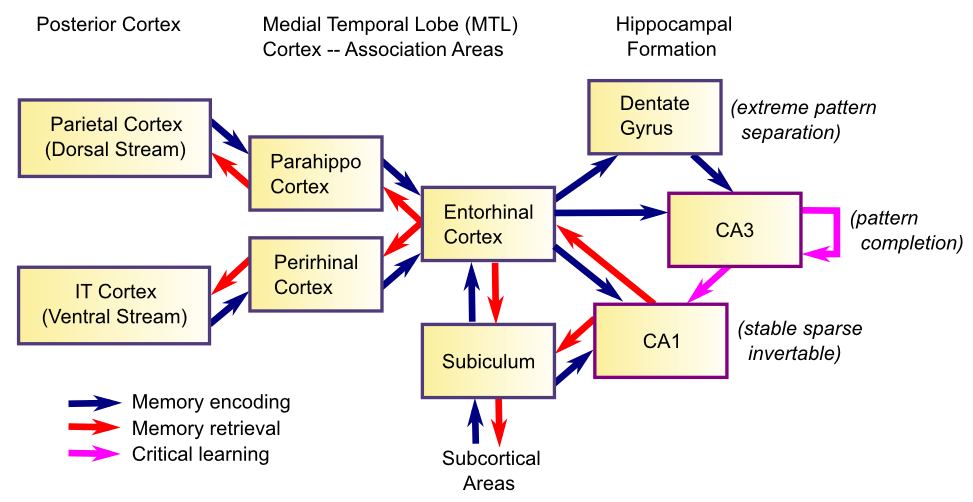
- The Inferior Temporal, Superior Temporal Cortex, and Parietal Cortex are maybe the main cortical-> hippocampus efferents for visuospatial stimuli.
-
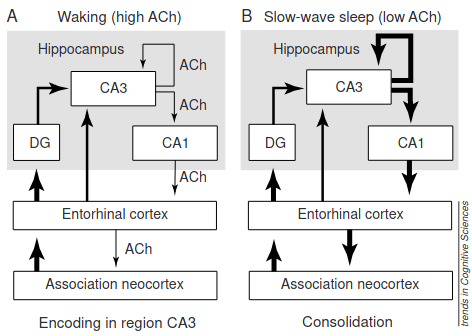
-

-
http://www.scholarpedia.org/article/Hippocampus written by Buzsaki.
- Hints of ‘Hippocampus as search engine’ can be gleaned here.
- one may hypothesize that the neural algorithms that evolved initially for the computation of first-order (neighborhood) and higher order (e.g., short-cuts, detours) distances in the physical world are fundamentally the same as those used for navigation in cognitive space and for the computation of relationships among perceived, conceived or imagined items.
- Making a map requires exploration of the environment by self-referenced (egocentric) dead-reckoning type of navigation, (i.e., the same method as used by Christopher Columbus to discover the New World). Similarly, generation of semantic (i.e., self-independent or allocentric) knowledge requires prior self-referenced episodic experience. For these reasons, it has been hypothesized that the mechanisms underlying dead reckoning navigation and episodic memory (’navigation in cognitive space’) are the same
-
-
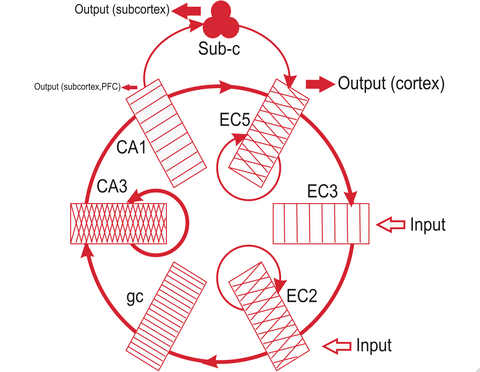
- The CA1 is the main ‘cortical output’ of the hippocampus!
- I guess he means hippocampus proper here. CA1→Subiculum and CA1→Entorhinal, and everything else→entorhinal probably contribute more.
- The CA1 is the main ‘cortical output’ of the hippocampus!
- Hints of ‘Hippocampus as search engine’ can be gleaned here.
Anatomy #
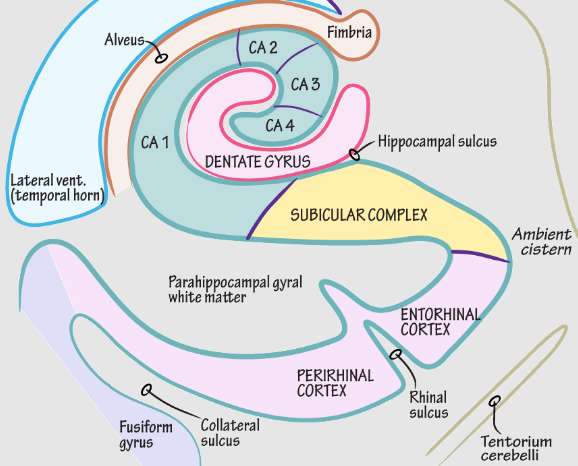
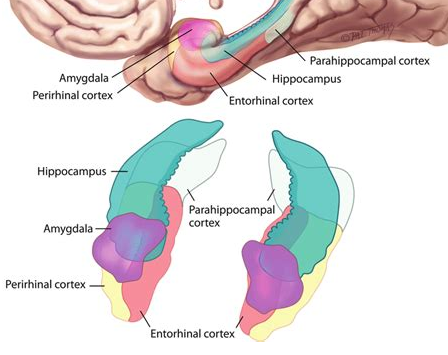 Found in the allocortex in like the temporal area.
Found in the allocortex in like the temporal area.
- “Hippocampus” may refer to either the hippocampal formation: a somewhat loosely-defined structure consisting of some combination of:
- The hippocampus proper, Dentate Gyrus, subiculum, presubiculum, parasubiculum, Perirhinal Cortex, and Entorhinal Cortex
- Or only the hippocamus proper, which is divided into CA (cornu Ammonis) 1-4:
- The ‘Schaffer collaterals’ are Pyramidal Neuron projections from the CA3 to CA1.
-
Two-stage model of memory trace formation: A role for “noisy” brain states (Buzsaki 1989)
- The two principal cell types of the hippocampus, the pyramidal neurons and granule cells, are maximally active during different behaviors. Granule Cells reach their highest discharge rates during Theta-concurrent exploratory activities, while population synchrony of Pyramidal Cells is maximum during immobility, consummatory behaviors, and slow wave sleep associated with field sharp waves
Hemispheric #
There’s a heap of studies specifically on Neural Oscillations with regards to this stuff. Granted the hippocampus is probably the most ubiquitous subject of analysis for studies on brainwaves.
-
Left tends to be more verbal, and the right more spatial. But, spatial especially I think, they of course interact with one another intricately.
-
The rodent hippocampus as a bilateral structure: A review of hemispheric lateralization
- The left hemisphere stores spatial information as discrete, salient locations, and the right hemisphere represents space continuously, contributing to route computation and flexible spatial navigation.
- I definitely do wonder how rodents and humans differ in this sense as they aren’t capable of actual language. Of course they have ‘verbal’/‘syntactic’ correlates but that’s an additional layer of abstraction one has to deal with. But I think this study does not contradict other findings: “discrete, salient locations” sounds more ‘verbal’ than “continuous space”.
- The left hemisphere stores spatial information as discrete, salient locations, and the right hemisphere represents space continuously, contributing to route computation and flexible spatial navigation.
-
- left hippocampal volume was the best predictor of free recall and delayed free recall of verbal information. Recall and delayed recall of the spatial location of verbal items were best predicted by right hippocampal volume. Memory scores did not correlate either with parahippocampal gyrus or temporal lobe volume
- The relation between hippocampal volume and memory function observed in cases with AD did not hold for healthy aged control subjects.
- Don’t throw the baby out with the bathwater: I wonder what this implies. Surely individual differences are just statistically insignificant (but maybe there are some weird savants out there, or qEEGs) as they don’t have legit atrophied hippocampi? I’m going with that one.
Place cells #
- Place cells encode a roughly spherical area in space, activating when the animal’s position is there. Artificially stimulating them in mice makes mice think they’re at the place since it exhibits learned behaviors corresponding to it.
- They encode diferent place fields in different environments. Rotation of the environment for instance maintains relative positions but induces a corresponding rotation of the place field.
- These cells also encode non-spatial information, like a scalar of frequencies when rats move a lever up/down to change pitch to receive a reward.
- Superimposition of ‘grid cells’ translates to place cell activation, further down the hippocampus.
